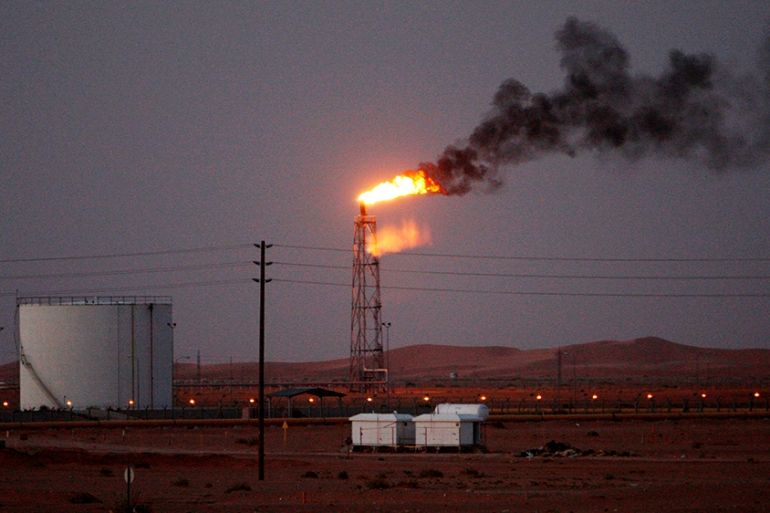Double whammy: Oil, shares tumble on OPEC fallout, virus fears
Saudi Arabia’s shock decision to increase oil output after OPEC talks failed has rattled markets reeling from virus.

Asian shares sank on Monday as panicked investors fled to bonds to hedge against the economic shock of the coronavirus and oil prices plunged about 30 percent after Saudi Arabia slashed its official selling price.
The world’s top oil exporter plans to raise its production significantly after the collapse of OPEC’s supply cut agreement with Russia, a grab for market share reminiscent of a drive in 2014 that caused prices to slump by about two-thirds.
Keep reading
list of 3 itemsAramco shares below IPO price for first time as OPEC deal fails
Coronavirus roils markets: this is why it matters to everyone
Brent crude futures fell by as much as $14.25, or 31.5 percent, to $31.02 a barrel. That was the biggest percentage drop since January 17, 1991, at the start of the first Gulf War and the lowest price since February 12, 2016. It was trading at $35.75 at 01:14 GMT.
Japan’s yen, seen by many investors as a safe-haven asset in times of economic weakness, surged against emerging market currencies with exposure to oil, including the Russian rouble and Mexican peso, as analysts saw danger ahead.
“Today’s price action puts at risk the fiscal health of the vast majority of sovereign producers and budget cuts and increased debt loads are now looming in the event of a prolonged period of low prices,” warned Helima Croft, head of global commodity strategy at RBC Capital Markets.
“For the most politically and economically fragile producer states, the reckoning could be severe.”
Saudi Arabia and Russia are arguing over the price and flow of oil. That, and the Fake News, is the reason for the market drop!
— Donald J. Trump (@realDonaldTrump) March 9, 2020
There were also worries that United States oil producers that had issued a lot of debt would be forced into bankruptcy by the price drop.
Energy stocks took a beating, with E-Mini futures for the S&P 500 already down 4.7 percent. Japan’s Nikkei fell 4.4 percent and Australia’s commodity-heavy market 5 percent.
MSCI’s broadest index of Asia-Pacific shares outside Japan lost 1.2 percent.
“The scale of the collapse shows that any hopes of a temporary respite were in vain,” said Sean Callow, a senior FX strategist at Westpac. “The notion that overweight equities is the only real option in a world of super-low rates now seems to be from ‘The Time Before’.”
“US officials have barely moved beyond platitudes about ‘strong fundamentals’ so there is surely plenty more room for markets to price in major damage to the US economy.”
The number of people infected with the coronavirus rose above 107,000 across the world as the outbreak reached more countries and caused more economic carnage.
Italy’s markets are sure to come under fire after the government ordered a lockdown of large parts of the north of the country, including the financial capital Milan.
“After a week when the stockpiling of bonds, credit protection and toilet paper became a thing, let’s hope we start to see some more clarity on the reaction,” said Martin Whetton, head of bond & rates strategy at CBA.
“Dollar bloc central banks cut policy rates by 125 basis points, not as a way to stop a viral pandemic, but to stem a fear pandemic,” he added, while noting many had little scope to ease further.
Bond bubble
Investors are widely expecting at least a half-percentage-point rate cut from the US Federal Reserve at its scheduled policy meeting on March 18 following last week’s emergency easing and a move towards zero not long after.
The European Central Bank meets on Thursday and will be under intense pressure to act, but rates there are already deeply negative.
“The onus is falling, perhaps inevitably on the actions of governments to abandon budget surpluses and reinvigorate the demand side of the economy,” said Whetton.
Urgent action was clearly needed with data suggesting the global economy slid into recession this quarter. Figures out from China over the weekend showed exports fell 17.2 percent in January-February, from a year earlier.
Analysts at BofA Global Research estimated the latest sell-off had seen $9 trillion in global equity value vapourised in nine days, while the average 10-year yield in the developed world hit 16 basis points, the lowest in 120 years.
“The clearest outcome of the exogenous COVID-19 shock is a collapse in bond yields, which once panic fades can induce huge rotation to ‘growth stocks’ and ‘bond proxies’ in equities,” they wrote in a client note.
Yields on 10-year US Treasuries plunged to a once-unthinkable 0.51 percent, having halved in just eight sessions.
Yields on the 30-year long bond dived 35 basis points on Friday alone, the largest daily drop since the 1987 crash, and were last down further at 1.13 percent.
The tumble in yields and Federal Reserve rate expectations have pulled the rug out from under the US dollar, sending it crashing to the largest weekly loss in four years.
The US dollar extended its slide in early Asia to reach 103.55 yen, depths not seen since late 2016, while the euro shot to the highest in more than eight months at $1.1387.
Gold jumped 1.6 percent to clear $1,700 per ounce to reach a fresh seven-year peak.